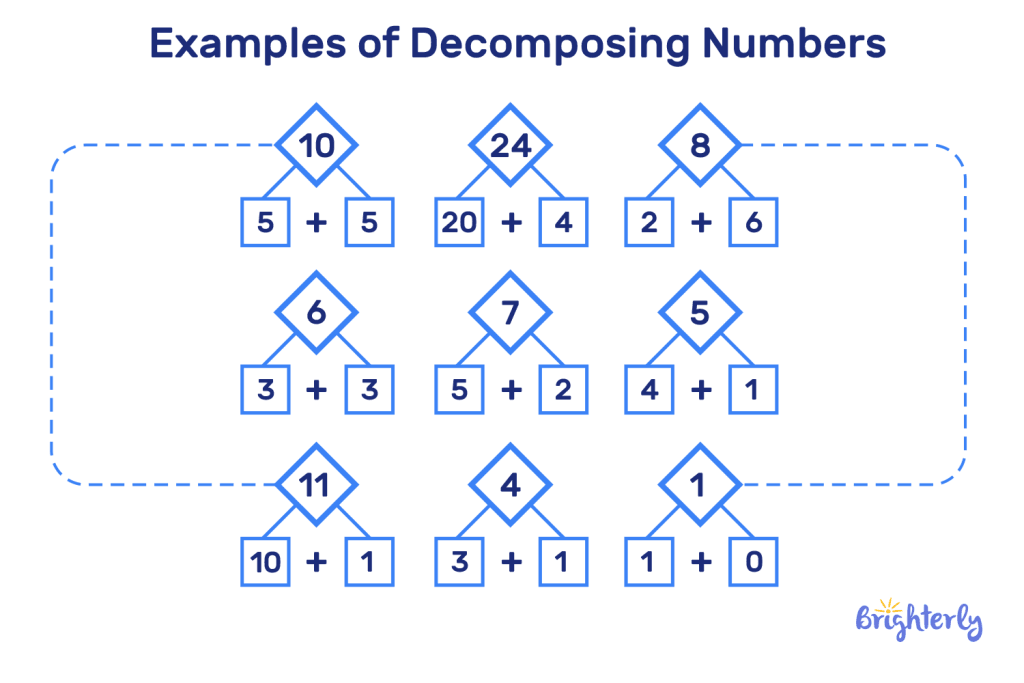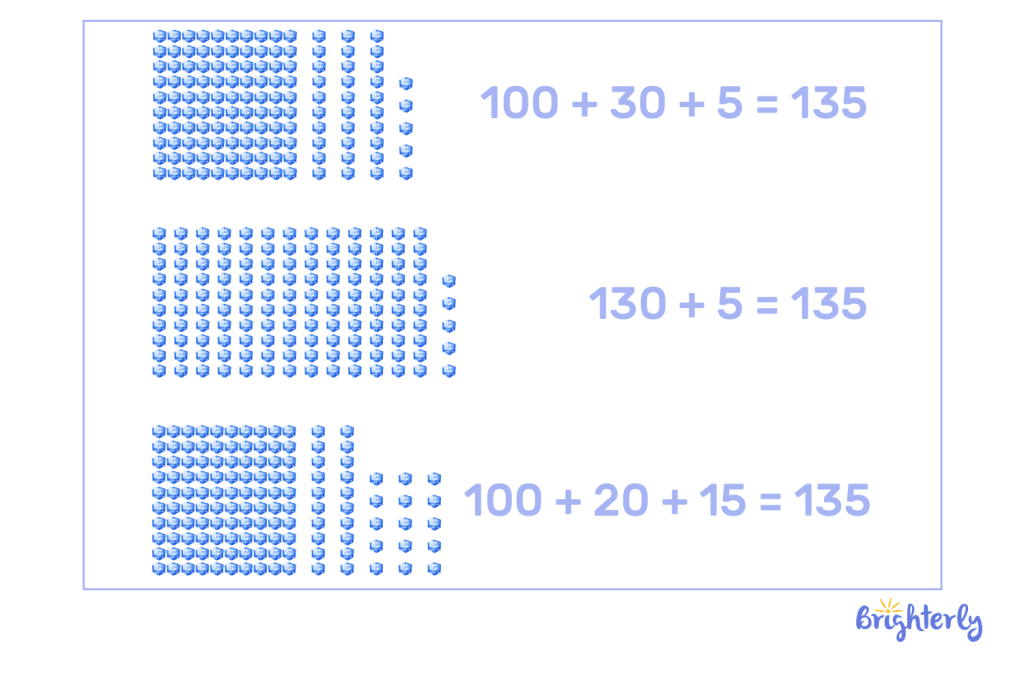Decomposing Numbers in Math – Definition, Methods & Examples
reviewed by Camille Ira B. Mendoza
Updated on October 28, 2025
Welcome to Brighterly, where you can grab valuable info about important math concepts and also get some useful tactics to make math much easier. Today, we’re going to focus on the tactic of decomposing numbers. As you might have guessed, this means breaking down numbers into smaller parts to make them easier to work with.
Number decomposition is useful when working with tricky sums, like multiplication and division, when you want to make them more manageable. Here, you’ll get to know about the decompose meaning in math, its properties, and various ways you can use it to simplify math.
What is number decomposition in math?
Number decomposition is the process of breaking numbers down into smaller components, making them easier to work with. The ability to decompose in math is often introduced early in the learning process because it can help children break down more complex problems. For example, you’ll often use it in multiplication and division to simplify tricky equations. Plus, it helps with a lot of other skills, including number sense and mental math.

Definition of number decomposition
The definition of number decomposition describes the act of breaking down larger numbers into smaller numbers that compose them. Conversely, the smaller numbers you get as the result of decomposition can then be added up to form the total of your larger number.
Often, in number decomposition, you’ll break down numbers into their place value parts. For example, you’d break down the number 249 into 200 (hundreds place), 40 (tens place), and 9 (ones place). Now that we’ve explained what does decompose mean, we’ll take you through how to decompose math numbers.
Methods of decomposing numbers
Here, we’ll show you how to decompose numbers using these 3 methods.
- Place value method: Break down your number into its place values. For example, 493 becomes 400, 90, and 3
- Addends method: Break down the number into numbers that add up to its total (addends). For example, 493 can also become 400 and 93
- Prime factorization: Break down your number into its prime factors. For 493, this would be 17 x 29

How to decompose a number with prime factorization
Prime numbers are numbers that only have two factors: 1 and themselves. Prime factors, meanwhile, are factors of other numbers that are prime numbers themselves.
Let’s use 12 to show an example of decomposing a number with prime factorization. To do this, divide 12 by its smallest prime factor, 2, and you get 6. Divide that again and you get 3, which is itself a prime factor. Therefore, the prime factorization of 12 is 2 x 2 x 3, or 22 x 3.
Decomposing Fractions 4th grade Worksheet
Decomposing Fractions 4th grade Worksheet
Decomposing Fractions Worksheet
Decomposing Fractions Worksheet
Using place value to decompose numbers
In math, place value refers to the position each digit in our number is in, which represents a value. Places include thousands, hundreds, tens, and ones.
Let’s look at an example. The number 829 can be broken down into:
- 800 (the hundreds place value)
- 20 (the tens place value)
- 9 (the ones place value)
Working with these numbers individually can be easier than working with a number like 829.
Decomposing a number breaking into addends
Finally, let’s look at decomposing a number by breaking it into addends. With this method, you split your number into 2 or more smaller numbers, ensuring they add up to your original number.
Using the addend method means you can break up a number into any combination of its addends. For example, you can break up 9 into some of the following addends:
- 4 + 5
- 8 + 1
- 3 + 3 + 3
Using the addend method means you can work with smaller numbers that you find easiest to work with.
Properties of decomposed numbers
Now that you know the decompose math definition, it’s time to look at decomposed numbers more deeply. Decomposed numbers have a range of interesting properties. These are:
- The property of identity: The original number always stays the same
- The property of order: No matter what order you put your decomposed numbers in, the original number remains the same
- The property of associativity: No matter how you group your decomposed numbers, the original number remains the same
Properties of number decomposition using prime factorization
Number decomposition through prime factorization has a unique property: the prime factors are unique to that number. This is known as the fundamental theorem of arithmetic. This theorem states that all numbers larger than one are either prime numbers or can be decomposed into prime factors.
Properties of number decomposition using place value
A key property of decomposed numbers using place value is that they have additive values, meaning that you add up these numbers to get to your original number.
Properties of number decomposition by breaking into addends
Like decomposing numbers with place value, breaking numbers into addends also means that the sum of the numbers will total your original number. This can also be known as the partition of a set, which is the division of a number into subsets that all add up to the total of that number.
Difference between the various methods of decomposing numbers
You’ll use different methods of composing and decomposing numbers for different purposes.
- The place value method, for example, works best for complex math problems. If you have a sum like 238 + 351, it’s easier to add the individual place value numbers together than to add in one go.
- Decomposing by addends helps you understand the additive structure of numbers, and can also make math problems easier if there are some numbers you find easier to work with.
- Finally, the prime factorization method helps you understand the multiplicative structure of numbers.
Equations illustrating number decomposition
Let’s use a decomposing numbers example and create equations using all the different methods of number decomposition. If we take 24, we can use prime factorization to decompose this into 2 x 2 x 2 x 3, or 23 x 3.
Using the place value method, we decompose the number 24 into 20 and 4. Finally, using the addends method, we can decompose 24 into several options, including 10 + 4 + 4, 10 + 14, 15 + 9, and more.
Writing equations using prime factorization
To write a decomposing numbers equation using prime factorization, you should first divide your number by its smallest prime number. If we use the above example of 24, 24 ÷ 2 = 12. Keep dividing by 2 and you’ll get 6, then 3. As 3 is another prime factor, your prime factorization becomes 2 x 2 x 2 x 3, or 23 x 3.
Writing equations using place value decomposition
To write decomposing numbers equations using place value decomposition, you’ll simply need to split out your number into its place values, replacing any remaining digits after them with 0s.
For example, 921 becomes 900 + 20 + 1.
Writing equations using breaking into addends
To write equations using number decomposition via addends, you simply need to write down your chosen addends in an equation. For example, if you’ve broken 75 down into 30, 40, and 5, your equation would be 30 + 40 + 5 = 75.
Practice problems on decomposing numbers
Now that you know what does decompose mean in math, it’s time to test your understanding of decomposing numbers. Try out these practice problems and write down your answers.
- Decompose the number 45 using the prime factorization method
- Using the place value method, decompose the number 1028
- Using the addend method, decompose the number 92
Conclusion
Here, you’ve learnt the definition of decomposing numbers, the different ways to do it, and how to compose and decompose numbers. Now you know all about how and why to decompose numbers in math, and the top 3 methods for doing so!
Decomposing numbers will be a useful trick in your toolkit when it comes to solving complex operations in multiplication, division, addition, or subtraction, and it can also apply to fractions. This knowledge sets you up for a successful journey in math.
Frequently asked questions on decomposing numbers in math
What does it mean to decompose a number?
Decomposing a number breaks it up into smaller parts that all combine to total the value of your number. By decomposing a number, you can make it easier to work with.
What are the different methods of decomposing numbers?
There are 3 different methods of decomposing numbers:
- Prime factorization method – break a number down to its prime factors
- Place value method – break it down by its digit’s place values
- Addend method – break it down into a combination of its addends
How does decomposing numbers help in mathematical problem-solving?
Decomposing numbers helps in mathematical problem-solving because it can make complex equations simpler. Breaking down a large number into its components – for example, its place values – can make it easier to work with, as you can add or multiply elements separately.






